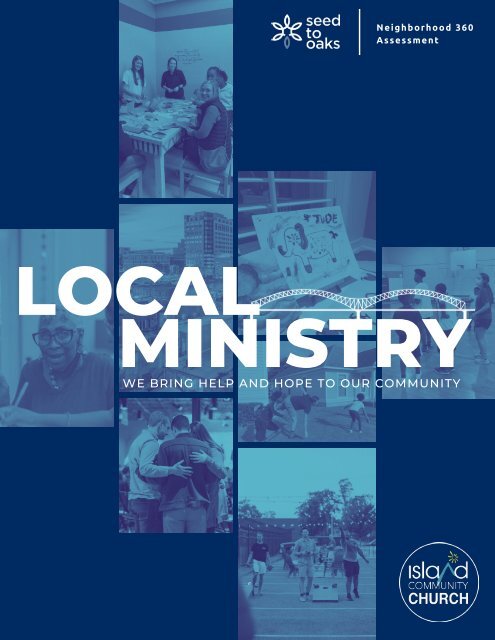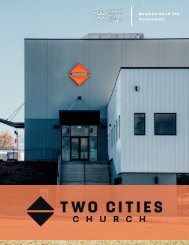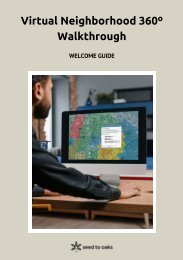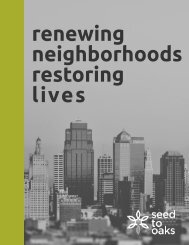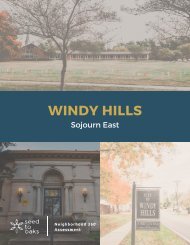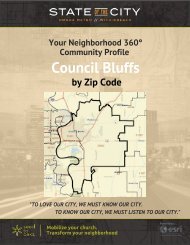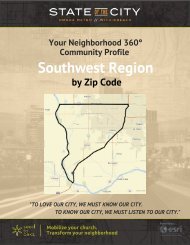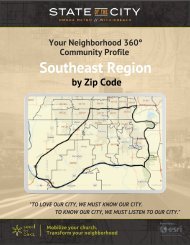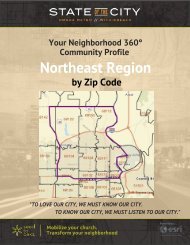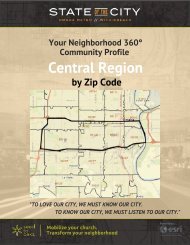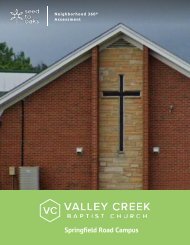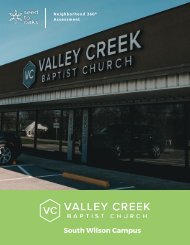Island Community Church
You also want an ePaper? Increase the reach of your titles
YUMPU automatically turns print PDFs into web optimized ePapers that Google loves.
Neighborhood 360<br />
Assessment<br />
LOCAL<br />
MINISTRY<br />
WE BRING HELP AND HOPE TO OUR COMMUNITY
YOUR NEIGHBORHOOD 360 ASSESSMENT<br />
Introduction<br />
History of <strong>Island</strong> <strong>Community</strong> <strong>Church</strong><br />
Mud <strong>Island</strong> <strong>Community</strong><br />
Uptown <strong>Community</strong><br />
Midtown <strong>Community</strong><br />
South Main <strong>Community</strong><br />
What's My Next Step?<br />
2<br />
3<br />
4<br />
11<br />
16<br />
21<br />
25<br />
1
<strong>Island</strong> <strong>Community</strong> <strong>Church</strong> Local Ministry<br />
WE BRING HELP AND HOPE TO OUR COMMUNITY.<br />
God's grace brings salvation and restoration to our lives<br />
and moves us to extend His gospel and grace to others.<br />
(2 Cor. 5:11-21, Rom 1:16, Rom. 10:12-17, Jer. 29:7, Micah 6:8,<br />
Matt. 25:31-41)<br />
INTRODUCTION<br />
Why we began the study: <strong>Island</strong> <strong>Community</strong> <strong>Church</strong> began the Neighborhood 360<br />
Assessment process with a desire to learn more about our community and how to best<br />
meet its needs.<br />
Our goal was to more effectively learn how to bring help and hope to our community.<br />
We desired to see where God was already at work and how we could join Him.<br />
We recognized that our location strategically placed us at the intersection of 4<br />
communities within a 15-minute drive from our church:<br />
Mud <strong>Island</strong> (the community where the church was planted to reach)<br />
Uptown (the community in which the church currently gathers within to worship)<br />
Midtown (a long-term residential community within the heart of the city)<br />
South Main <strong>Community</strong> (a Downtown neighborhood experiencing rapid<br />
development)<br />
The main goal was to gain insight into each community, leading to greater kingdom<br />
effectiveness as a church and within the lives of our individual members. We hoped this<br />
information, coupled with community connections, would give us insight into greater<br />
gospel opportunity, inform mercy ministry outreach, and empower church planting<br />
efforts within the city.<br />
2
HISTORY OF ISLAND COMMUNITY CHURCH<br />
Hoyt Lovelace planted ICC on Mud <strong>Island</strong> in Downtown Memphis in 2003. ICC was<br />
planted to meet a need in a new community where no church existed. All of the land on<br />
Mud <strong>Island</strong> was privately owned, which prevented a church building development. In<br />
2004, the church moved to Maria Montessori School. ICC moved again in 2011 off Mud<br />
<strong>Island</strong> into nearby Downtown.<br />
Barrett Bowden became the lead pastor in 2011. In 2013, under his leadership, the church<br />
moved into its current facility and community on North Parkway in a unique opportunity<br />
orchestrated by God in partnership with St. Jude/ ALSAC.<br />
Being a city center church has provided exciting opportunities to embrace ministry that<br />
reaches a transient people. Throughout the last 20 years, our church has had opportunity<br />
to impact the lives of thousands. We cherish the opportunity to reach the unreached,<br />
disciple and equip, and send leaders throughout our country and around the world.<br />
As ICC has grown, so has the diversity of our church family. We've seen the ministry<br />
continue to expand to empty nesters, families, young professionals, and students from<br />
University of Tennessee Health Science Center, Southern College of Optometry, and The<br />
University of Memphis.<br />
We're excited that over the last 10 years, God has called our church into increasing<br />
effectiveness across the many diverse communities of our city, including firmer roots in<br />
the neighborhoods around our current facility. The church has also continued to solidify<br />
its commitment to planting healthy churches, sending out global missionaries, and<br />
growing in diverse membership that represent our many communities.<br />
3
MUD ISLAND COMMUNITY<br />
N E I G H B O R H O O D S N A P S H O T<br />
Mud <strong>Island</strong> is a peninsula adjacent to Downtown<br />
Memphis with boundaries of Mud <strong>Island</strong> Road,<br />
Grand <strong>Island</strong> Drive, Front Street, part of North<br />
Second Street, and <strong>Island</strong> Drive. This community is<br />
neighbored by the Uptown and Pinch Districts.<br />
Mud <strong>Island</strong> is home to a diverse collection of<br />
individuals, including longer term residents who<br />
reside primarily in Harbor Town, transient residents<br />
such as professional students, St. Jude and other<br />
hospital employees, and many internationals.<br />
“Known for its scenic parks, luxurious homes,<br />
apartments, and walkable shops and eateries, the<br />
Mud <strong>Island</strong> community brings out the best in<br />
Memphis style and charisma. Developed by Henry<br />
Turley Company in 1989, the community was one<br />
of the first to venture into the new urbanism<br />
movement, essentially, a community designed for<br />
human interaction. Single family homes and<br />
apartments were built around a live, work, and<br />
play center that includes a school, a grocery store,<br />
a salon, a gym, several restaurants, and parks."<br />
(<strong>Community</strong> Redevelopment Agency, n.d., para. 3)<br />
Mud <strong>Island</strong> is the community that <strong>Island</strong><br />
<strong>Community</strong> <strong>Church</strong> was planted to reach.<br />
H I S T O R Y O F M U D I S L A N D<br />
4<br />
At the beginning of the 20th century, Mud <strong>Island</strong> was<br />
nothing more than a sandbar that was frequently<br />
underwater. In the 1910s, the USS Amphitrite was<br />
rumored to have run aground at the sandbar<br />
resulting in even more deposition of matter on the<br />
emerging land mass. Though the ship was loosed<br />
two years later, the land continued to build up. It had<br />
been called “City <strong>Island</strong>,” but the name “Mud <strong>Island</strong>” –<br />
by the US Army Corps of Engineers and Mississippi<br />
River Flood Commission – prevailed.
During the mid-20th century, farming squatters would live on the land and eventually be<br />
evicted. For a time, city planners considered creating the first park for Black people on<br />
the land, but Mayor E.H. Crump did not want such a park within city limits. The island<br />
used to have an airstrip in the 1950s called Memphis Downtown Airport. In 1960, the<br />
north end of the island was dammed up (North Mud <strong>Island</strong> Road travels over it today),<br />
thus forming a peninsula rather than an island. In 1965, Mud <strong>Island</strong> was annexed into the<br />
city of Memphis. The construction of the I-40 Hernando DeSoto Bridge, which went<br />
directly over the airstrip, resulted in the deposition of tons of earth matter onto Mud<br />
<strong>Island</strong> causing the land to rise an additional 20 feet over the floodplain. This opened the<br />
possibility to build permanent buildings on the land.<br />
Mud <strong>Island</strong> River Park opened July 4, 1982. That same year, a proposal was submitted to<br />
the city to build an office park (replete with two 37-story buildings), sports complex, and<br />
apartments on the island. This initial plan ultimately did not materialize. This plan<br />
envisioned building a bridge to the island, as well as carrying part of I-40 over the island.<br />
The lack of easy access to the island from Downtown was a major impediment to<br />
development on Mud <strong>Island</strong>. In 1988, Riverset Apartments began construction as the first<br />
modern building project on the island. At that time, there was still discussion of a<br />
possible highway being built over part of Mud <strong>Island</strong>. Construction began on Harbor<br />
Town in 1989, and the Maria Montessori School opened in 1992. The next development<br />
was the <strong>Island</strong> Crest community, then subsequent apartment complexes and homes<br />
along <strong>Island</strong> Place.<br />
5
D E M O G R A P H I C I N S I G H T S<br />
Mud <strong>Island</strong> has a higher concentration of adults between the ages of 25-44 than<br />
similar communities throughout Memphis<br />
45% of Mud <strong>Island</strong> residents are between ages of 25-44<br />
Mud <strong>Island</strong> is 62% White, compared to 26% White throughout the rest of Memphis<br />
Mud <strong>Island</strong> residents represent primarily one-person family homes<br />
Mud <strong>Island</strong> residents represent significantly higher income than the average Memphis<br />
household income<br />
The median household income of Mud <strong>Island</strong> residents is 1.5-2x the median<br />
household income of other Memphis communities.<br />
The average household income for White residents is $98,000/yr and Black<br />
residents is $45,000/yr representing similar trends of economic disparity among<br />
other Memphis communities<br />
A staggering 80% of the population over 25 years old have a degree greater than high<br />
school and 19% are enrolled in a graduate school program.<br />
The international population on Mud <strong>Island</strong> (12%) is 3x higher than Memphis as a<br />
whole<br />
I C C C O M P A R E D T O M U D I S L A N D<br />
<strong>Island</strong> <strong>Community</strong> <strong>Church</strong> reflects the age demographics of the Mud <strong>Island</strong> community<br />
with comparable percentages of students, professionals, young families, and empty<br />
nesters. The current racial composition of ICC is predominantly White with a smaller<br />
proportion of members of varying ethnicities, again representing comparable<br />
percentages to Mud <strong>Island</strong>. One point of demographic deviation between ICC and Mud<br />
<strong>Island</strong> residents are with internationals – the international population represents about<br />
12% of Mud <strong>Island</strong> residents and only around 5% of ICC attenders. The church generally<br />
reflects the socioeconomic and educational status of Mud <strong>Island</strong>. The Harbortown<br />
neighborhood represents the smallest proportion of ICC members on Mud <strong>Island</strong> and the<br />
greatest opportunity to reach long-term residents.<br />
6
N E I G H B O R H O O D O B S E R V A T I O N S<br />
Mud <strong>Island</strong> has the feeling of being removed from Downtown Memphis.<br />
Mud <strong>Island</strong> residents know very little about the other neighborhoods of the city. Many<br />
residents live on the island to be near Downtown without the feeling of living<br />
downtown. This includes limited interaction with homelessness, crime, and parking<br />
challenges.<br />
The community is full of organizational leaders and city influencers.<br />
Primary vocations of Mud <strong>Island</strong> residents fall into three sectors – business & corporate<br />
jobs, medical & health professional jobs, and hospitality jobs. Business/corporate<br />
employees include those in sales, banking, engineering, pilots, and similar jobs. There is<br />
a large population of medical and medical-adjacent professionals, including medical<br />
students or health science related graduate students. Hospitality includes individuals<br />
working in several roles such as restaurants, building management, and property<br />
development.<br />
Many residents spend time outside of their homes.<br />
There is generally lots of outdoor activity. The park on Mud <strong>Island</strong> brings people from<br />
both homes and apartments on Mud <strong>Island</strong> as well as people from around the city who<br />
do not live on Mud <strong>Island</strong> but appreciate the safe and clean outdoor space.<br />
Cordelia’s Market is one of the most loved institutions and connecting points for residents.<br />
This grocery and community hub is the primary place where residents purchase<br />
groceries as other grocery stores are around 15 minutes away from Mud <strong>Island</strong>.<br />
4<br />
7
N E I G H B O R H O O D O B S E R V A T I O N S ( C O N T ' D )<br />
There are several small businesses on Mud <strong>Island</strong> that cater to the residents living close by.<br />
Restaurants popular to Mud <strong>Island</strong> residents include Tugs, local food trucks, and<br />
Paulette’s.<br />
The Nail Bar, Harbor of Health, Higginbotham Dental, and Mud <strong>Island</strong> Dry Cleaners<br />
service residents' day to day health and lifestyle needs.<br />
Most families with children on Mud <strong>Island</strong> have children under 10 years of age.<br />
Many families live in multi- and single-family homes on Mud <strong>Island</strong>. Our <strong>Community</strong><br />
Observation Team saw mostly families with children younger than 10-13. There are a<br />
large number of families with younger children, many utilizing the Montessori school<br />
and the Foreign Language Immersion Childcare Center. Families also utilize Downtown<br />
Elementary School, other charter schools, or private schools.<br />
Additional observations:<br />
While neighborhood associations are not open to outsiders, residents are not unwilling<br />
to be friendly or communicate.<br />
The Mud <strong>Island</strong> neighborhoods and apartment complexes are very well maintained.<br />
There is a decent amount of car and foot traffic on the southern portion of the island,<br />
representing a mixture of residents and non-residents, that can get especially busy on<br />
the weekends.<br />
8<br />
4
<strong>Church</strong>es and Spiritual Life<br />
There are currently no churches on Mud <strong>Island</strong>. <strong>Island</strong><br />
<strong>Community</strong> <strong>Church</strong>, Downtown <strong>Church</strong>, First United Methodist,<br />
Calvary Episcopal, Pioneer <strong>Church</strong>, and St. Peters are the<br />
closest in proximity to Mud <strong>Island</strong>, but all likely require a car to<br />
attend.<br />
Mud <strong>Island</strong> is filled with mainly highly educated and hardworking<br />
individuals. It appears that church or spiritual<br />
relationships are not a priority among the residents as most identify as atheist or<br />
agnostic. This appearance does not preclude residents from having spiritual needs, but<br />
they may not have the space or language to express those needs. Mud <strong>Island</strong> residents<br />
expressed desire to have more or deeper relationships with family, friends, and those<br />
they live within close proximity to.<br />
Neighborhood Survey Findings<br />
Mud <strong>Island</strong> residents generally enjoy living near Memphis but not feeling like they live<br />
in Memphis. Residents noted enjoying nature, feeling safe, and proximity to small<br />
communities as reasons for Mud <strong>Island</strong> feeling unique to Memphis proper.<br />
Mud <strong>Island</strong> residents interviewed indicated a desire to deepen the community by<br />
connecting with neighbors. Similarly, residents noted that the church could take a<br />
role in addressing the lack of close community of residents on Mud <strong>Island</strong>.<br />
Residents acknowledged that people’s physical needs on Mud <strong>Island</strong> are generally<br />
met, but the needs seem to be more emotional and spiritual as people largely keep to<br />
themselves.<br />
<strong>Community</strong> and Cultural Tensions<br />
The Mud <strong>Island</strong> neighborhoods seem to be homogenous and not have many community<br />
problems beyond lost pets and potholes. The apartments tend to be more diverse with<br />
people from all over the world. The residents are generally individualistic and keep to<br />
themselves. Occasionally, the Homeowners Associations activity creates transient<br />
disgruntlement with some Harbor Town residents.<br />
<strong>Community</strong> Wants, Needs and Dreams<br />
The primary hope for the Mud <strong>Island</strong> community is simple: to build strong community<br />
ties. For the people living on Mud <strong>Island</strong>, there is the desire for residents to use shared<br />
spaces and resources as a path to connect more with one another. Additionally, Mud<br />
<strong>Island</strong> has the opportunity to utilize its own assets to help the economic and educational<br />
disparity in the surrounding neighborhoods.<br />
9
C A L L T O A C T I O N<br />
We believe these are the primary Actionable Insights we can help address:<br />
There is an opportunity for partnership and connection between Mud <strong>Island</strong><br />
and our church including with businesses and schools.<br />
Residents are lonely, and this needs to be recognized.<br />
Our church should pursue an emphasis on relational stewardship and<br />
genuine relationships rather than more programming, specifically more<br />
intentionality for people new to the community and people on the fringes.<br />
Additional Insights to help build relationships with our neighbors:<br />
Mud <strong>Island</strong> gives off a closed off (insider vs. outsider) vibe, but there is a<br />
desire for connection between residents.<br />
There is a great spiritual and relational need, but this can often go<br />
unidentified by residents.<br />
The international population of Mud <strong>Island</strong> is unique in that it is slightly<br />
larger than the rest of the city of Memphis. 12% of Mud <strong>Island</strong> residents are<br />
internationals.<br />
There appears to have been a "withdrawn-ness" among community leaders<br />
It is important that we ponder this question:<br />
How do we connect with the residents and visitors on Mud <strong>Island</strong>?<br />
10
UPTOWN COMMUNITY<br />
N E I G H B O R H O O D S N A P S H O T<br />
Uptown is a community in Memphis comprising North Memphis and the neighborhoods<br />
historically known as Greenlaw and the Pinch District. Uptown is bordered by Chelsea<br />
Avenue, A.W. Willis Avenue, Danny Thomas Street, and Front Street. The neighborhoods<br />
surrounding Uptown include Mud <strong>Island</strong> and Downtown to the South, Frayser to the<br />
North, and Midtown to the East. The community is composed of long-term community<br />
residents, emerging professionals, and lower-income residents living under public<br />
housing or subsidized statuses. The population of Uptown is primarily Black, but is<br />
becoming more diverse each year, as the up and coming community attracts residents<br />
from different socioeconomic statuses, backgrounds, and ethnicities.<br />
H I S T O R Y O F U P T O W N<br />
In 1843, the U.S. Navy built a depot on the Mississippi River near current day A.W. Willis<br />
Street, which attracted development in the area. In 1849, brothers Oliver and William<br />
Greenlaw began buying land along with investors. Eventually, the Greenlaw addition to<br />
Memphis was built. Many businesses were Black-owned and operated and led to the<br />
development of a Black middle class. At one time, Uptown was a place of notable racial<br />
and socioeconomic diversity. When a large number of starving Irish Catholics began<br />
immigrating to the area, these new residents were malnourished with “pinched”<br />
stomachs leading to the area mockingly being dubbed “The Pinch District.”<br />
Large floods to the area in 1912 and 1937 led to many upper class residents moving away<br />
and more working class and lower income families moving in. With the loss of its upper<br />
class residents, the Uptown community also lost its political pull. This loss of economic<br />
and political input resulted in a decline in the area. The decline was further exacerbated<br />
by white flight and redlining in the mid-1900s. The area would experience a period of<br />
high crime and poverty in the 1980s and 1990s.<br />
11
For around 50 years, the 100 blocks in the Greenlaw community was left behind by<br />
developers in the city. To see a snapshot of what Hurt Village and the Greenlaw<br />
community was like before the Hope VI federal grant, you can watch the movie The<br />
Blind Side. Michael Oher, the movie's protagonist, was originally from Hurt Village.<br />
After hearing how much Harbor Town and Mud <strong>Island</strong> residents enjoyed their<br />
remodel, Henry Turley, one of the main developers, asked himself the question,<br />
“Can we apply the same development pattern to lower income neighborhoods<br />
with similar, positive results?"<br />
In the late 1990s, the Memphis Housing Authority with the City of Memphis<br />
received a Hope VI federal grant from the U.S. Department of Housing and Urban<br />
Development to tear down and redevelop Hurt Village and Lauderdale Courts<br />
areas. This redevelopment aimed at restoring the community without<br />
gentrification or the displacing of current residents. While some residents were<br />
weary of developers in the early stages of Uptown’s redevelopment, they attained a<br />
new sense of pride in their community. Residents also became more empowered<br />
homeowners. Condemned homes and vacant lots were cleared while mixed<br />
income apartments were built. The apartments were equally split between public<br />
housing, subsidized housing, and market rate housing. During this revitalization,<br />
the name “Uptown” was adopted instead of “Greenlaw.”<br />
D E M O G R A P H I C I N S I G H T S<br />
30% of Uptown residents are between ages of 45-64<br />
Uptown is 81% Black. The Black population of Uptown is comparatively larger than<br />
the 64% ratio of Black residents in the city as a whole<br />
Around 75% of Uptown residents rent and do not own their homes<br />
Around 25% of residents receive Social Security or some form of public assistance<br />
Many households have 1 or no vehicle. Residents rely on carpooling, public transit, or<br />
rideshare services<br />
Most residents of Uptown work in administration and office support<br />
23% of Uptown residents have a college degree<br />
12
I C C C O M P A R E D T O U P T O W N<br />
The demographics of <strong>Island</strong> <strong>Community</strong> <strong>Church</strong> do not currently reflect the<br />
demographics of the Uptown community racially, socioeconomically, and educationally.<br />
ICC does not have a proportionately equivalent number of Uptown residents within its<br />
membership in comparison to Mud <strong>Island</strong> and Midtown. Uptown is predominantly Black<br />
and has a larger proportion of older adults and children than that of ICC. Additionally,<br />
nearly half of Uptown residents are one person households. One area of notable similarity<br />
between Uptown and ICC is that many community members rent rather than own their<br />
living spaces. The former Hurt Village, as seen in the movie The Blind Side, is directly<br />
across the street from <strong>Island</strong> <strong>Community</strong> <strong>Church</strong>.<br />
N E I G H B O R H O O D O B S E R V A T I O N S<br />
Visually, Uptown homes look similar to homes in Harbor Town and Mud <strong>Island</strong>.<br />
Uptown is an up and coming area.<br />
There are a few completely empty houses, but they are well-maintained.<br />
The people are warm and generally receive others kindly.<br />
While some expressed little community engagement, there seems to be familiarity<br />
between neighbors.<br />
Children of all ages are seen in the neighborhood.<br />
There is increasing concern for safety the further north you live in the neighborhood.<br />
City investment and federal grants are creating higher demand residences in Uptown.<br />
13
<strong>Church</strong>es and Spiritual Life<br />
A number of churches are located in the Uptown area. They<br />
include New True Vine Missionary Baptist <strong>Church</strong>, Centennial<br />
Baptist <strong>Church</strong>, Holy <strong>Community</strong> <strong>Church</strong>, United Methodist<br />
Center, Bible Way Holiness <strong>Church</strong>, Friendship <strong>Church</strong> of the<br />
Nazarene, Tuckers Temple <strong>Church</strong> of God, Christian Unity Baptist<br />
<strong>Church</strong>, First Baptist <strong>Church</strong> of Chelsea, St. Stephen Missionary<br />
Baptist, and Grace <strong>Church</strong>. Many of these churches are small<br />
with active membership of less than 100 people. There does not seem to be a sense that<br />
the <strong>Church</strong> has an active and loving relationship to the Uptown residents we spoke with;<br />
however, the churches in Uptown love their community. There does not seem to be much<br />
movement among neighbors on Sundays. A few people are connected to neighborhood<br />
churches, but many people are disconnected.<br />
Neighborhood Survey Findings<br />
Residents in Uptown enjoy the quietness, location, and renovation of the neighborhood.<br />
Uptown residents would like to see changes in various facets of their community<br />
including community infrastructure such as grocery stores, bus stops, and community<br />
organizations. They would also like to see changes in crime and security.<br />
The primary concerns with how a church could make a difference in the community<br />
include providing resources for the youth and cultivating close community ties.<br />
<strong>Community</strong> and Cultural Tensions<br />
The community seems to have lost its identity when the old public housing was removed<br />
and the new houses were built. For some long-term residents in the neighborhood, it feels as<br />
if they are waiting for their community to be taken away in the name of progress. With<br />
construction all around the neighborhood, it remains to be seen if it will stay a community<br />
with mixed socio-economic statuses, backgrounds, and ethnicities. There is the potential for<br />
new residents to replace the existing demographics as the developments to the north and<br />
west progress, along with St. Jude's expanding footprint.<br />
There are several other social issues causing tension within the community. Crime remains a<br />
problem as with much of Memphis. Some residents feel safe on their streets, but many<br />
mentioned 7th Street having issues with gangs. There is also a large concern about lack of<br />
resources for youth in the area. The closing of MAM may leave a vacuum for youth in the<br />
community. Homelessness remains a problem in Uptown. There is also a lack of community<br />
and connectedness in the neighborhood. Most people keep to themselves and know few<br />
people around them.<br />
<strong>Community</strong> Wants, Needs, Dreams<br />
The community hopes to provide young people employment and opportunities within the<br />
neighborhood as a way out of the cycle of poverty and gangs.<br />
14
C A L L T O A C T I O N<br />
We believe these are the primary Actionable Insights we can help address:<br />
Many homes have been refurbished by the CRA. Uptown is an up and<br />
coming community because of the presence of developers. What role can<br />
we play in the continued development of Uptown?<br />
Reaching kids when they are young is critical to turn the trajectory of<br />
generational poverty. What would a thriving children's ministry look like in<br />
Uptown?<br />
We have the opportunity to connect with other churches and pastors who<br />
are investing in the community and youth successfully<br />
Additional Insights to help build relationships with our neighbors:<br />
Uptown isn’t as “scary” or unsafe as their reputation leads people to<br />
believe.<br />
There is a great need for youth outreach. This is a great opportunity for<br />
life-on-life relationships.<br />
People are open to conversations and extend warm invitations to come<br />
inside homes.<br />
Many tensions are at play about the future of the Uptown community.<br />
It is important that we ponder this question:<br />
How can we educate ourselves and learn how to be community<br />
advocates for those living in Uptown?<br />
15
MIDTOWN COMMUNITY<br />
N E I G H B O R H O O D S N A P S H O T<br />
Midtown is a community located within the boundaries of Jackson Avenue, Lamar<br />
Avenue, Airways Boulevard, East Parkway, Trezevant Street, and I-69. Midtown is<br />
neighbored by Binghamton and part of Orange Mount to the East; Orange Mound,<br />
Glenview, and Annesdale to the South; and the Medical District and Uptown to the West.<br />
Generally, Midtowners are known to be eco-conscious, music and art loving, generally<br />
left-leaning, and loyal to their community.<br />
H I S T O R Y O F M I D T O W N<br />
In 1899, the city of Memphis expanded by annexing to Cooper Street. This happened<br />
again in 1909 by annexing to East Parkway. Additionally, both Central Gardens – which<br />
was in the community of Lennox – and the Evergreen neighborhood were incorporated<br />
into the city of Memphis. Midtown was like the city’s “original suburbs”--built to be a<br />
prestigious neighborhood outside of the city center. Post World War II, many of the large<br />
properties were divided into duplexes as the volume of people able to afford the<br />
impressive properties could not meet the volume of such properties.<br />
In the 1950s, developers were interested in routing Interstate 40 through Overton Park.<br />
The citizens formed the Citizens to Preserve Overton Park Inc., which took the case to the<br />
US Supreme Court. The residents of Overton Park won in Citizens to Preserve Overton<br />
Park v. Volpe in 1971. By the time the decision was announced, several houses had already<br />
been demolished as builders had begun to prepare the area for interstate highway<br />
construction.<br />
As Memphians increasingly moved east by 1970, Midtown crime increased, property<br />
values decreased, and the area garnered a reputation of urban decline.<br />
16
In the 1970s, however, Midtown began to revitalize. The founding of the Cooper-Young<br />
<strong>Community</strong> Association in 1975 assisted in this transformation by renovating old homes<br />
and lobbying for ordinances to prevent absentee ownership. Ultimately, the events<br />
surrounding the I-40 decision spawned the formation of powerful, historic district<br />
associations that hold great sway to this day.<br />
D E M O G R A P H I C I N S I G H T S<br />
One-third of Midtown residents are young adults between the ages 25-44<br />
The Midtown population is 66% White, 23% Black, and 4% Hispanic<br />
Over half of residents are single-person households which is well above city and<br />
national averages<br />
Income levels of Midtown residents reflect city averages<br />
There are significantly lower rates of SNAP assistance and persons living below the<br />
poverty line in the Midtown community<br />
Midtown is a well-educated area of the city. At least half of all midtown residents have<br />
attained higher education<br />
Midtown is a creative and arts hub for the city of Memphis<br />
I C C C O M P A R E D T O M I D T O W N<br />
ICC shares similarities to the Midtown community, though Midtown still has some<br />
characteristics that distinguish it from the general church makeup. Both have a highly<br />
educated population and notable amounts of collegiate students, while Midtown as a<br />
whole has a larger Black representation and is more progressive leaning in ideology. Both<br />
ICC and Midtowners have a disposition towards community engagement and<br />
improvement, seeking causes and partnerships that foster restoration and build up the<br />
marginalized of society. A commonality of heart for service and neighborhood well-being<br />
exists between our church and Midtown, which lends itself towards bridge building even<br />
in the presence of diverging ideologies and spiritual states.<br />
17
N E I G H B O R H O O D O B S E R V A T I O N S<br />
Midtown as a whole is diverse (racially and socio-economically), but the pockets<br />
of the individual neighborhoods that compose it are not very diverse.<br />
While Midtown seems to be most attractive to younger populations, in the<br />
historic Midtown neighborhoods like Central Gardens and Evergreen there is a<br />
larger middle-aged population.<br />
Midtown is full of restaurants, nightlife, parks, and shopping which attract and<br />
support the diversity of the community.<br />
Midtown is a community proud of their uniqueness. "Midtown is Memphis."<br />
Midtown is a tolerant and accepting community. There is a wide range of<br />
lifestyles, beliefs, and practices present in the area.<br />
Midtown is the kind of place the garners strong reactions - you either love it or<br />
you don't.<br />
There are many schools in Midtown ranging from private schools (both religious<br />
and non-religions), Memphis and Shelby County schools, and charter schools.<br />
18
<strong>Church</strong>es and Spiritual Life<br />
There are a large number of churches located in the<br />
Midtown community. These churches represent a number<br />
of denominations. <strong>Church</strong>es in Midtown include Mosaic<br />
<strong>Church</strong>, Open Door Bible <strong>Church</strong>, Trinity United Methodist<br />
<strong>Church</strong>, First Congregational, Lindenwood Christian, Union<br />
Avenue Baptist, Sacred Heart <strong>Church</strong>, Healing a Generation<br />
<strong>Church</strong>, Bluff City <strong>Church</strong>, Divine Temple of God, Memphis<br />
Tabernacle, Apostolic <strong>Church</strong>, Iglesia Amistad Cristiana, and<br />
Cathedral of Immaculate Conception.<br />
Midtown could be categorized as a spiritually open-minded community. Midtown is<br />
very spiritually diverse, offering many options for worship. Many of these churches or<br />
religious centers have been in operation for decades in Memphis. Biblical Christianity<br />
is on the decline within many churches and most people have developed the attitude<br />
that what one believes shouldn’t matter to anyone else. Should someone wish to<br />
engage in spiritual activities, it does seem that there should be a place for anyone’s<br />
given individual lifestyle preferences.<br />
Neighborhood Survey Findings<br />
Midtown residents generally enjoy the location, neighbors, and diversity of Midtown.<br />
Crime, homelessness, and affordable housing are noted concerns of Midtown<br />
residents, although there were many surveyed who did not state any concerns with<br />
living in Midtown.<br />
<strong>Community</strong> care, outreach, and help for the homeless are areas where residents<br />
stated the church could make a difference.<br />
<strong>Community</strong> and Cultural Tensions<br />
Most of the community tensions in Midtown form out of fears around crime and<br />
homelessness. There is a real tension among residents around being open to providing<br />
care and housing solutions for the homeless community and the personal safety of<br />
residents.<br />
As Midtown has continued to grow and develop, housing prices and the cost of rent is<br />
pricing out many residents, especially those involved in the arts and service industries,<br />
both which are crucial to supporting the unique culture of Midtown. There's also concern<br />
for the racial tensions of the city. The activist mentality among midtown lends toward<br />
active involvement in resolving oppression in its various forms.<br />
19
C A L L T O A C T I O N<br />
We believe these are the primary Actionable Insights we can help address:<br />
Midtown residents want to be involved. Are there community activities<br />
and service opportunities we can coordinate and invite the<br />
community to join in?<br />
Midtown is eclectic yet stable, and residents take a lot of ownership in<br />
their community. This means creativity will be needed as we engage in<br />
ongoing relationships. Many individuals will likely not see their need<br />
for the gospel.<br />
Yet, Midtowners are open to inclusive spiritual experiences. In the<br />
same way Paul sought to find things in common with those in Athens<br />
(Acts 17), we should seek to find commonality as we share the love and<br />
truth of Christ, through the gospel.<br />
Additional Insights to help build relationships with our neighbors:<br />
There are few churches per capita related to population. How can we<br />
become the church everyone sees as the church who is actively caring for<br />
their community?<br />
Midtown has a lot of interaction across cultures and races due to the<br />
community's walkable access to diverse restaurants, shopping,<br />
entertainment, and parks. When out in the community, do we see<br />
ourselves as representatives of God's Kingdom?<br />
Proximity to entertainment and local cultural activities help shape a<br />
Midtowner’s identity and community.<br />
It is important that we ponder this question:<br />
How can we express true love to our neighbors in such a diverse<br />
(spiritually and culturally) community while not compromising our<br />
faith?<br />
20
SOUTH MAIN COMMUNITY<br />
A note on our engagement within the South Main <strong>Community</strong><br />
We were able to take preliminary steps to obtain a brief overview of the South Main<br />
community, including demographic information and some community observations.<br />
However, we will take a deeper dive into the opportunities of the South Main<br />
community once we have more church members residing within this neighborhood.<br />
Residents are essential to establishing deeper relationships with community leaders<br />
and help provide inroads into the unique ministry opportunities to this community.<br />
We hope to make these exploratory connections during 2023.<br />
N E I G H B O R H O O D S N A P S H O T<br />
The community of South Main lies within the boundaries of Dr. MLK Jr Avenue to the<br />
North, South Carolina Avenue to the South, Second Street to the East, and Riverside Drive<br />
to the West. It is neighbored by Downtown to the north and other industrial areas.<br />
Today, more than 3,500 people live in South Main drawn to the neighborhood’s charm,<br />
walkability, and proximity to Downtown amenities. It’s home to dozens of shops,<br />
restaurants, and creative organizations which are locally owned and operated. South<br />
Main has kept true to its origins by being a neighborhood built by those committed to<br />
the community.<br />
H I S T O R Y O F S O U T H M A I N<br />
Until 1850, what is now South Main was actually a separate city from Memphis called the City<br />
of South Memphis. South Memphis was the residential suburb of Memphis and remained<br />
that way until the early 1900s when the railroad stations were built.<br />
Because of Memphis’ geographical location in the country, it was an ideal city to become the<br />
center for railroad traffic. As a result, South Main began to transform from a residential<br />
neighborhood into a business center to support the booming railroad traffic. Manufacturing 21<br />
and distribution warehouses were also drawn to South Main to be near railroads.
By the 1950s, the railroad industry was beginning to<br />
crumble and with it supporting businesses – fewer stops<br />
in Memphis meant fewer customers. At the same time,<br />
manufacturing began migrating east to industrial parks,<br />
leaving many large warehouses vacant and falling into<br />
disrepair. The assassination of Dr. Martin Luther King Jr. at<br />
the Lorraine Hotel in 1968 and the ensuing riots were the<br />
final blow for South Main. After that, the area was<br />
essentially abandoned and neglected for 20 years.<br />
Ironically, South Main was saved because of its<br />
abandonment: its architectural gems were kept intact<br />
because no developers were interested in the area. As a<br />
result, the buildings in South Main look much like they<br />
did in the early 1900s.<br />
South Main’s renaissance truly began in 1982 when<br />
Robert McGowan and Annie Mahaffey bought 418 South<br />
Main Street as their home and art studio. Other artists<br />
soon followed. Robert lobbied the city for much-needed<br />
infrastructure and code enforcement to preserve the<br />
historic buildings. More awareness of the neighborhood<br />
came with the openings of major anchors like the<br />
National Civil Rights Museum in 1991 and the<br />
establishment of the Trolley Line in 1993.<br />
22<br />
4
D E M O G R A P H I C I N S I G H T S<br />
54% of South Main residents are between the ages of 25-44<br />
The South Main community population is 66% White, 25% Black, and 3% Asian<br />
62% of residents are single-person households and live alone<br />
The average income of the Black residents of the South Main community is 2x the<br />
average income of Black residents in the rest of the City of Memphis<br />
The South Main community is a well-educated area of the city with 77% of residents<br />
holding at least a college degree<br />
Occupations in business, finance, legal, and entertainment are the predominant<br />
career paths of residents<br />
New construction is providing avenues of growth in this developing residential<br />
community<br />
I C C C O M P A R E D T O S O U T H M A I N<br />
<strong>Island</strong> <strong>Community</strong> <strong>Church</strong> and the South Main <strong>Community</strong> are composed mainly of welleducated,<br />
socioeconomically stable, working young adults. However, South Main<br />
residents, on average, represent greater financial wealth and Black representation than<br />
ICC. Furthermore, the demographics of ICC represent a higher percentage of families<br />
with children and fewer single-person households than the South Main community. In<br />
general, South Main’s demographic, educational, and socioeconomic profiles provide a<br />
solid foundation for future opportunity and outreach because of the ease of assimilation.<br />
4<br />
23
N E I G H B O R H O O D O B S E R V A T I O N S<br />
South Main has a rich commercial life. Many<br />
businesses have opened in the past decade. Local<br />
businesses located in the South Main community<br />
include Southpoint Grocery Store, the South Main<br />
Arts District, 387 Stock & Belle, 901 Health and<br />
Wellness Clinic, 901 Real Estate Services, The<br />
Arcade Historic Restaurant, Arrive Hotel Memphis,<br />
The Blues Foundation, Catherine & Mary’s<br />
Restaurant, EZR Rental Management, Feelin’<br />
Memphis Shops, Guaranty Bank, Wiseacre<br />
Brewing, The Memphis Farmers Market, and Loflin<br />
Yard.<br />
South Main has a number of government and<br />
political entities located within the neighborhood.<br />
These are the Tennessee Department of Human<br />
Services, the DCS Shelby County Regional Office,<br />
and the National Civil Rights Museum.<br />
Three churches are located within the boundaries<br />
of South Main – Downtown <strong>Church</strong>, <strong>Church</strong> of the<br />
River, and The Life <strong>Church</strong> Downtown.<br />
Wiseacre Brewing and Old Dominick Distillery are<br />
two industrial establishments within South Main.<br />
Multi-family housing in condos and apartment<br />
buildings is common throughout the South Main<br />
area. There is also single-family housing in the<br />
South Bluffs neighborhood.<br />
24<br />
There are a number of bars, restaurants, and coffee<br />
shops throughout the South Main District that<br />
many locals frequent. These include Bar Hustle,<br />
Longshot, The Green Beetle, Eight & Sand, Slider<br />
Inn, SOB Downtown, Earnestine & Hazel’s, Vice &<br />
Virtue, Bluff City Coffee, Mr. Beans Coffee, and<br />
Hustle & Dough. The South Main <strong>Community</strong><br />
Association is also a point of community<br />
connection.
R E F E R E N C E S<br />
<strong>Community</strong> Redevelopment Agency, "Uptown TIF District<br />
Neighborhood Profiles", Harbor Town/ Mud <strong>Island</strong>,<br />
https://cramemphis.org/uptown-tif/#1625147945026-c23ff219-ce8b<br />
Henry Turley Company, "Our Work", Uptown,<br />
https://www.henryturley.com/work/uptown/<br />
South Main Association, "South Main: The District",<br />
https://www.gosouthmain.com/history<br />
29
ISLAND COMMUNITY CHURCH<br />
721 North Parkway<br />
Memphis, TN 38105<br />
(901) 300-0422<br />
ICCMemphis.com
W H A T I S M Y N E X T S T E P I N B R I N G I N G<br />
H E L P A N D H O P E T O O U R C I T Y ?<br />
L E A R N I N G A T I C C : W O R K S H O P S & C L A S S E S<br />
Our workshops and classes are learning environments that resource attendees<br />
with skills to engage with our culture, share their faith, and experience<br />
community with other like-minded believers. Current workshops include:<br />
Sharing Your Faith<br />
This workshop occurs 3 times a year.<br />
The goal is to help believers articulate the gospel, practice sharing the gospel,<br />
and pray for non-Christians.<br />
Apologetics in the City<br />
This workshop helps believers give a defense for cultural issues and<br />
worldviews they encounter within our culture.<br />
This workshop is offered once in May each year.<br />
Book Studies On Current Social Issues<br />
These workshops provide a space for seekers, believers, and non-believers to<br />
discuss different cultural issues and/or book studies together.<br />
These workshops are offered as needed.<br />
The 5 Capitals<br />
This workshop uniquely aids believers in identifying the felt needs of every<br />
type of community, from the seemingly impoverished to the apparently<br />
affluent communities whose needs may not be as obvious. These include<br />
spiritual (a broken relationship with God), relational (lack of healthy<br />
relationships and community), physical (lack of healthy rhythms and access<br />
to healthy food), intellectual (high concentrations of mental health issues like<br />
anxiety and depression) and financial (lack of a livable wage and resources for<br />
living) capitals.<br />
This workshop is offered once a year for those with a particular interest in<br />
local ministry and missional living.<br />
25
D I S C O V E R R H Y T H M S O F B E I N G A N D D O I N G<br />
P E R S O N A L L O C A L M I N I S T R Y<br />
We empower individual members to use their gifts, talents, and abilities to live on<br />
mission within the city where they live, work, and play. While we recognize that<br />
every believer is called to be a witness (Acts 1:8), we also know that God has<br />
chosen each believer in Christ to bear fruit in His name (John 15:16). We help each<br />
believer steward the gospel within their sphere of influence and enter into<br />
unique opportunities of service within the community.<br />
B E I N G<br />
Christ is our motivation and the source of our empowerment. Before we do<br />
anything of lasting value for God, we must abide in Him (John 15:4-5). As we<br />
navigate through our daily lives, we recognize that we live, move, and have our<br />
being in Him (Acts 17:28). Knowing whose we are prevents us from striving or<br />
seeking to produce fruit that will not last. Being safe and secure in Christ, we<br />
operate and bring the gospel into our community from a position of peace with<br />
God (Romans 1:7).<br />
D O I N G<br />
As we live within our God-given identity, we make Him known. Everything we do<br />
becomes a sacrifice to Him, including our work, our meal times, and our play.<br />
Work- We recognize that every earthly boss is subject to a higher authority. We<br />
do all of our work to please the Lord, not men. We build relationships with our<br />
coworkers to make Christ known (Col. 3:23).<br />
Live- We dwell in the land and cultivate faithfulness. We are faithful to God no<br />
matter where we live. We shine as beacons of light towards God for those around<br />
us (Ps. 37:3).<br />
Play- We live strategically. We leverage our hobbies and habits so as to outwardly<br />
position ourselves to share the gospel with those around us. Whether we eat or<br />
drink, we do it all for the glory of God (1 Cor. 10:31).<br />
26
G R O U P L O C A L M I N I S T R Y<br />
We encourage ICC community groups and individuals united around a specific<br />
ministry cause to engage in regular rhythms of service throughout our city.<br />
Groups are facilitated by leaders in the church or are an organized group of ICC<br />
volunteers committed to serve a specific partner.<br />
B E I N G<br />
Groups commit to check in with one another at least twice a month to pray<br />
for one another and their group's focused ministry needs.<br />
Individuals within groups commit to being growing disciples and to sharing<br />
what they are learning in God’s Word and as they serve in Local Ministry<br />
together.<br />
D O I N G<br />
Groups serve regularly at a set time and place for the good of the community<br />
and the furtherance of the gospel.<br />
Groups unite to use their individual giftings to the glory of God on dynamic<br />
teams.<br />
Group Local Ministry can form out of natural rhythms of community or be<br />
facilitated by the church and passionate leaders who organize new groups for<br />
the purpose of ministry.<br />
Examples of Group Local Ministry include:<br />
A community group who seeks to serve the neighborhood in which they<br />
meet by providing a monthly neighborhood gathering around safety. Utilizing<br />
this access point, the group members are able to deepen relationships with<br />
their neighbors, genuinely serve a community need, and bridge relational<br />
opportunities into spiritual conversations around peace that they have found<br />
in God even when they lack safety.<br />
A group is organized by a passionate leader to serve in regular rhythms with<br />
one of our community partners. These groups form out of the diversity of the<br />
church towards a specific cause.<br />
Groups can form to move toward a currently unrecognized community need.<br />
As God brings together people with unique passions for ministry, they can<br />
form groups to begin serving with a specific community emphasis.<br />
27
C H U R C H - W I D E L O C A L M I N I S T R Y<br />
We have quarterly opportunities to expose a broad swath of the community to<br />
our church. Our goal is to do a general outreach that meets felt needs within the<br />
city in order to have regular touch points for non-Christians. We also strive to<br />
model how to be good neighbors to our city. We seek the welfare of our city<br />
through broad sowing opportunities together as a church periodically<br />
throughout the year.<br />
Examples of these “broad sowing” opportunities include:<br />
St. Jude Marathon<br />
The St. Jude Marathon provides an opportunity for ICC to encourage marathon<br />
runners and raise awareness for families whose children experience pediatric<br />
cancer care. This yearly event occurs the first Saturday of December.<br />
<strong>Community</strong> Fall Fest<br />
The <strong>Community</strong> Fall Fest blesses our surrounding communities and partners by<br />
providing a space for connections. This yearly event occurs during the last<br />
Saturday of October.<br />
Shelby County School Events<br />
We engage in city-wide initiatives that affect educators and students within our<br />
city. Shelby County Schools provides various opportunities for outreach<br />
throughout the year, such as welcoming children back to school, providing<br />
appropriate clothing for students in need, and participating in literacy coaching.<br />
These events occur quarterly throughout the school year.<br />
<strong>Community</strong> Engagement<br />
Bi-monthly, we will enter into communities to intercede on their behalf. We also<br />
commit to learn more about each community by taking tours and hearing from<br />
local community members. We regularly engage with residents within each of<br />
our four main communities.<br />
28


